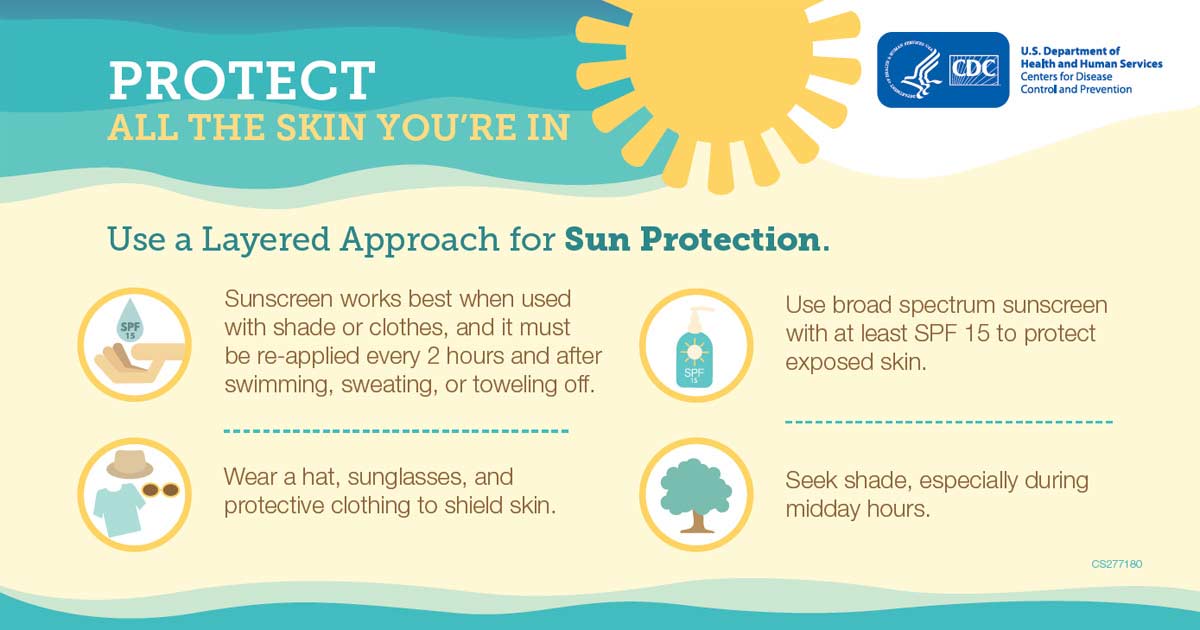Say "Yes" to Protecting Your Skin This Summer
Though summer is all about being outdoors, soaking up some vitamin D and enjoying the nice weather, it's important to note that skin cancer is the most common form of cancer in the United States. Thankfully, there are some steps you can take to lower your risk and protect your skin all year long.
According to the CDC, the most preventable cause of skin cancer is overexposure to ultraviolet (UV) light, either from the sun or from artificial sources like tanning beds. The counter this, the CDC recommends these tips for protecting your skin from the sun:
Shade
The CDC says you can reduce your risk of sun damage and skin cancer by staying in the shade under an umbrella, tree or other shelter. Your best bet to protect your skin is to use sunscreen or wear protective clothing when you're outside—even when you're in the shade.
Clothing
When possible, the CDC suggests wearing long-sleeved shirts and long pants and skirts, which can provide protection from UV rays. If wearing this type of clothing isn't practical, try to wear a t-shirt or a beach cover-up. Clothes made from tightly woven fabric offer the best protection. A wet T-shirt offers much less UV protection than a dry one, and darker colors may offer more protection than lighter colors. Some clothing is certified under international standards as offering UV protection.
Hats
For the most protection, the CDC recommends wearing a hat that has a brim all the way around that shades your face, ears and the back of your neck. A tightly woven fabric, such as canvas, works best to protect your skin from UV rays. Avoid straw hats with holes that let sunlight through. A darker hat may offer more UV protection. If you wear a baseball cap, you should also protect your ears and the back of your neck by wearing clothing that covers those areas, using sunscreen or staying in the shade.
Sunglasses
Sunglasses protect your eyes from UV rays and reduce the risk of cataracts. They also protect the tender skin around your eyes from sun exposure. The CDC says sunglasses that block both UVA and UVB rays offer the best protection. Most sunglasses sold in the U.S., regardless of cost, meet this standard. Wrap-around sunglasses work best because they block UV rays from sneaking in from the side.
Sunscreen
The CDC recommends applying broad spectrum sunscreen that blocks both UVA and UVB rays and has an SPF of 15 or higher before going outside. Don't forget to put a thick layer on all exposed skin. Get help for hard-to-reach places like your back. And remember, sunscreen works best when combined with other options.
Sunscreens are assigned a sun protection factor (SPF), which is a number that rates how well they block UV rays. Higher numbers indicate more protection. You should use a broad spectrum sunscreen with SPF of 15 or higher. Sunscreen wears off, so be sure to reapply again if you stay out in the sun for more than two hours and after swimming, sweating or toweling off. Also, check the sunscreen's expiration date. Sunscreen without an expiration date has a shelf life of no more than three years. Its shelf life is shorter if it has been exposed to high temperatures.

Photo courtesy of the CDC.
Courtesy of Groups Today.



